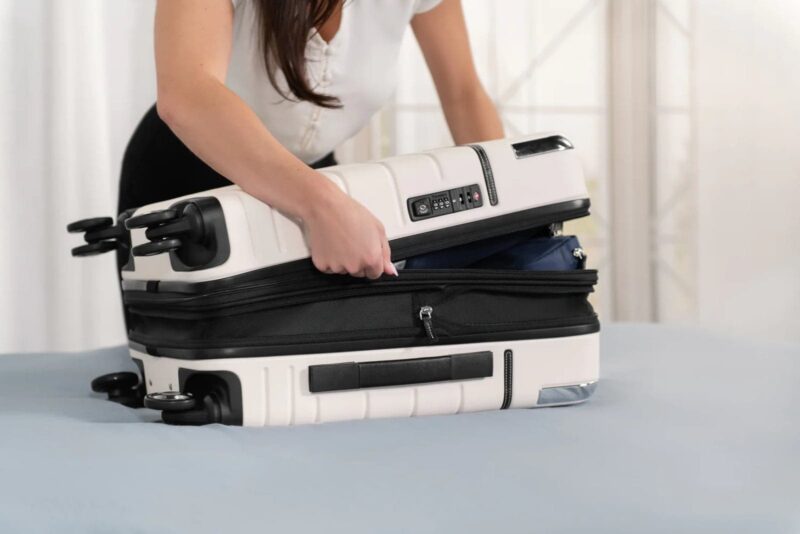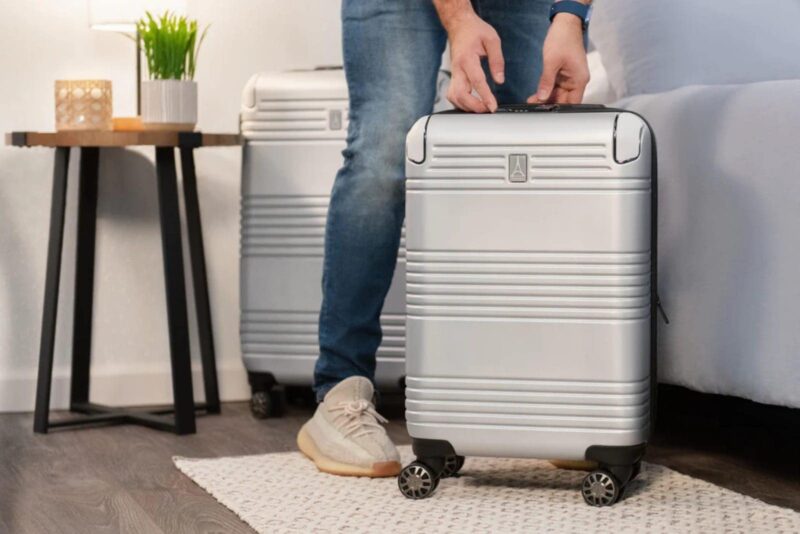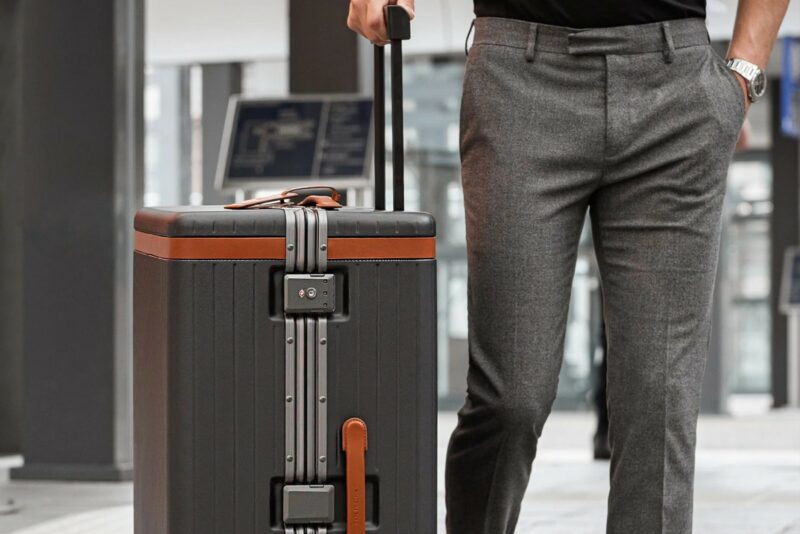Here’s a scenario you don’t want to be in: you roll up to the airplane gate and they ask you to see if your carry-on fits in the measuring box. No problem. You lift your suitcase, put it in, and… oops… it doesn’t fit. You flip it over, try to shove it in, jump on top of it. There’s no way it’s going in.
“Sorry,” says the gate agent. “You’re going to have to check that bag, and you’re going to have to pay for it.”
Fortunately, you don’t ever have to be in that situation. With just a little forethought, it’s easy to look up your airline’s size limit and measure your suitcase to be sure it will fit.
And trust me, it’s much better to learn how to measure luggage ahead of time so you don’t have to pay to check a bag you weren’t planning on paying for.
So, if you want to know how to measure your luggage, you’re in the right place. Let’s get started.
What You’ll Need to Measure Luggage
Measuring luggage is actually pretty straightforward, but you are going to need something to measure with (crazy, I know). A tape measure is the best option, but a yardstick will also do the trick.
And hey, if all you have is a dinky six-inch Care Bear ruler, you can make do with that. Remember the trick of measuring six inches, marking the spot with your finger, and measuring again from there? It’s not exact, but it’ll do the job.
In addition to some sort of measuring device, it’s handy to measure in an area with a hard floor next to a wall (we’ll get into this later).
I also recommend using a book, clipboard, or some other flat surface to make sure you get an accurate measurement.
If you want to weigh your luggage (which is a great idea), you’ll also need some sort of scale. A normal bathroom scale works well, but a luggage scale is cheap, compact, and easier to use. If you travel a lot, it might be a good thing to have.
If you want to get really fancy, Samsonite has a two-in-one tape measure/luggage scale combo. It’s pretty nerdy, but I’ll admit that I want one.
How To Find Airline Size Restrictions
The first thing you need to do is find the luggage size and weight restrictions for carry-on and checked luggage for the airline(s) you’ll be flying with. That’s as easy as Googling “[fill in your airline] luggage size restrictions.”
For example, if I Google “Frontier luggage size restrictions” the first result is a convenient FAQ page that shows Frontier’s size and weight limits.
It’s also helpful to understand the different types of luggage you are allowed to bring. Most airlines allow each passenger one personal item, one carry-on bag, and multiple checked bags.
Personal Item: 18″ x 14″ x 8″
Your personal item is a small bag or purse that can fit under the seat in front of you. I like using a personal item to keep electronics, books, snacks, and anything else I want close at hand while flying.
Personal item size limits will vary by airline, but the most common size is 18 inches high, 14 inches wide, and 8 inches deep.
Of course, if you bring a personal item carry-on that’s the max size, that means you won’t have any space to stretch out your feet.
Carry-On Luggage: 22″ x 14″ x 9″
Carry-on luggage will fit in the overhead bin on the airplane, so the exact luggage measurements are pretty important. If your bag is too big, it just won’t fit, and there’s not a lot of wiggle room. With carry-on baggage, it’s even more important to measure luggage precisely.
Carry-on size limits vary from one airline to the next, but the standard limit is 22 inches tall, 14 inches long, and 9 inches deep.
It’s important to note that carry-on limits for luggage for international travel are a bit different, with the standard carry-on luggage measurements for most international airlines being 21.5 inches x 15.5 inches x 9 inches.
Checked Luggage: 62 Linear Inches
Checked baggage is measured a little differently from carry-on bags. Instead of having maximum limits for the height, width, and depth, airline checked luggage size limits use what they call “linear inches,” which just means adding the overall dimensions together.
Most airlines limit checked bags to 62 linear inches (157 cm). Luckily, this covers most checked luggage you can buy, which will come with a height of anywhere from 26″ to 30″. The other dimensions are a combination of the inches remaining.
How To Measure the Height, Width, and Depth

When you’re ready to measure luggage size, the first information you’ll want to get is the height, width, and depth of your suitcase. These three numbers are the most important luggage measurements you’ll use to see if your luggage will fit.
Step 1: Fully Pack Your Suitcase
I recommend measuring luggage after it’s fully packed (as full as you’ll have it on your trip. You want to be as accurate as possible, and having a fully packed bag means you’ll be measuring luggage that will be the same size when you head to the airport.
This is especially important for measuring flexible softside bags and duffel bags. These more flexible bags can flex, bulge, and expand somewhat when you have them fully packed, so you want to make sure you know the real maximum size.
Step 2: Set the Suitcase By a Wall
Ideally, you’ll find an area in your home that has a hard floor surface next to a wall. Wheels count in total luggage size, and they’ll sink into carpet, meaning you won’t get an accurate measurement. Hard floors are the place to be.
Set your suitcase upright on its wheels, and back it up next to the wall. This will give you something straight to measure against.
Step 3: Use a Book and Measuring Tape to Measure the height
We’re finally to the part you’ve been waiting for: actually how to measure luggage size. This is where you’ll need to grab your tape measure (or yardstick) and a book.
The easiest way I’ve found to accurately measure the height of your suitcase is to place a book on top of the tallest point (including the handles) and hold it level (doesn’t need to be super precise, just make sure it looks flat).
To measure duffel bags, make sure you don’t push down too hard on the book, as that can squish your bag and give you an inaccurate luggage measurement.
Once you’ve got the book on top, you can use your tape measure or yardstick to measure the distance from the floor to the book. Using the book means you don’t have to eyeball a measurement from out to the side and can get a more accurate number.
Step 4: Flip and Repeat for Width and Depth
Once you’ve measured the height, flip your bag onto its side, and use the book and tape measure method again to measure from the floor to the highest point. This will be the width.
Then, flip your suitcase flat on its back. Use the same method one last time to measure from the ground to the highest point. This will be the depth.
Avoiding Confusion With Height, Width, and Depth
Some airlines will use different words than height, width, and depth. Some may call the width the length. Some may call the depth the width. Some may call the height the length.
In the end, it doesn’t matter. Just look at the numbers and make sure your suitcase dimensions are smaller than the airline restriction dimensions.
For example, if an airline says you need a bag that’s smaller than 24 inches long, 10 inches wide, and 16 inches tall, you’ll be totally fine if your bag measures 22 inches tall, 16 inches wide, and 10 inches deep.
When in doubt, ignore the words and look at the numbers.
How To Calculate Linear Inches (for Checked Bags)
When you’re figuring out how to measure luggage, you may come across the term linear inches in an airline’s size limit. This is a difference in the way airlines measure luggage between checked bags and carry-ons. Carry-ons will be measured by the three dimensions, while you measure checked bags with linear inches.
Essentially, linear inches just means you take the height, width, and depth you measured earlier, and then add them together.
Yep, that’s it.
Here’s a quick example: say I measured my checked bag and found it’s 24 inches tall, 18 inches wide, and 10 inches deep. I would then add those together: 24 + 18 + 10 = 52. So I now know that my checked bag is 52 linear inches.
It may seem like a weird way to measure luggage, but linear dimensions give you more flexibility in the shape of your luggage. A long, skinny bag and a short, fat bag can both fit within the restrictions.
How To Weigh Luggage

Not only do you need to make sure your suitcases fit within luggage size limits; you also need to check weight restrictions. Having a bag that’s over the maximum weight can lead to additional checked luggage fees or being forced to check your carry-on (also expensive). That’s why it’s important to figure out what your bag weighs ahead of time.
Again, the first step is to figure out what the weight limit is. The easiest way is just to Google “[fill in your airline] luggage weight limits.”
Typical limits are 50 lbs for checked bags, and anywhere from 15 to 35 lbs for carry-on luggage.
Once you know the weight limit, you can weigh your suitcase (fully packed, of course), to see if it fits.
Luggage Scale
The easiest way to check if your bag is under the weight limit is to use a luggage scale. These simple devices have a hook that goes through your suitcase handle.
Bathroom Scale
If you don’t have a luggage scale, a normal bathroom scale works just fine for measuring luggage weight.
Most likely, you’ll just be able to set your suitcase on the scale (probably sideways) and read the weight.
If your suitcase won’t fit on the scale (or covers up the numbers) you can use this old trick:
- Step on the scale to measure your own weight (write this down).
- Pick up the suitcase and step on the scale again to get the combined weight (write this down).
- Do some math: (combined weight) – (your weight) = (luggage weight)
What If My Bag Is Too Big (or Too Heavy)?

Okay, let’s say you’ve gone through the whole process to measure luggage dimensions, weigh luggage, and check the airline size and weight limits, but now you’ve got a problem: your bag is too big or weighs too much.
You still have a few options, and it’s going to depend on whether your oversize/overweight baggage is a carry-on or checked bag.
Carry-On Bags
Let’s start with the scenario where your carry-on suitcase is too big in one or more dimensions. Airlines will usually have a measuring box at the gate to make sure your bag is small enough, so if it fits in the box, you’re good.
That’s good news if you have a softside carry-on that’s just barely too big, because you might be able to squish it in to fit. Try this at home to see if you can squish it down enough to fit the limit.
If you have a hardshell bag that’s too big (or a softside that’s more than a bit over the size limit), you’re probably out of luck. Of course, it might not really make sense to go out and buy a new carry-on unless you’re going to be flying frequently with this airline.
Typically, your option for oversized cabin bags will just be to check them in. This does add some cost to your trip. I generally wouldn’t recommend trying to just slip aboard with a carry-on that’s oversize. If they figure out it’s too big, you’ll have to check it at the gate, which can be even more expensive. Plus, it might not even fit in the overhead compartments.
For overweight bags, you have a few more options. The best solution is to divide the weight between other luggage or bags. If you have a checked suitcase, move some stuff over to that. You can also bring an extra personal item to fit under the seat in front of you. Take some of the heaviest items from your carry-on, and put them in your personal item until you’re under the weight limit.
Checked Bags
With checked baggage, oversize and overweight bags are generally still allowed, you’ll just have to pay more. For bags over the weight limit, you can try the same trick of moving some weight into your carry-on or personal item.
How to Measure Luggage FAQs
What does 24 inch luggage mean?
24 inch luggage is 24 inches tall (or where the longest dimension is 24 inches).
What size suitcase is 62 linear inches?
Most large checked baggage fits within 62 linear inches. A bag that’s 28” x 20” x 14” would fit.
How do suitcase measurements work?
Checked bags use linear inches, or the height, width, and depth added together.
Is a 24 inch suitcase too big?
A 24-inch suitcase is great for checked baggage and will work as a carry-on for a few airlines.
What is the largest size carry-on baggage allowed?
The most common size limit for carry-ons is 22” x 14” x 9” or for international: 21.5” x 15.5” x 9”
